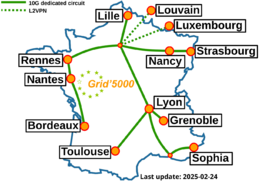Grid5000:Home
|
Grid'5000 is a large-scale and flexible testbed for experiment-driven research in all areas of computer science, with a focus on parallel and distributed computing including Cloud, HPC and Big Data and AI. Key features:
Grid'5000 is merging with FIT to build the SILECS Infrastructure for Large-scale Experimental Computer Science. Read an Introduction to SILECS (April 2018)
Older documents:
|
Random pick of publications
Five random publications that benefited from Grid'5000 (at least 2928 overall):
- Maxime Agusti, Eddy Caron, Benjamin Fichel, Laurent Lefèvre, Olivier Nicol, et al.. PowerHeat: A non-intrusive approach for estimating the power consumption of bare metal water-cooled servers. 2024 IEEE International Conferences on Internet of Things (iThings) and IEEE Green Computing & Communications (GreenCom) and IEEE Cyber, Physical & Social Computing (CPSCom) and IEEE Smart Data (SmartData) and IEEE Congress on Cybermatics, Aug 2024, Copenhagen, Denmark. pp.1-7. hal-04662683 view on HAL pdf
- Clément Barthélemy, Francieli Zanon Boito, Emmanuel Jeannot, Guillaume Pallez, Luan Teylo. Implementation of an unbalanced I/O Bandwidth Management system in a Parallel File System. RR-9537, Inria. 2024. hal-04417412 view on HAL pdf
- Quentin Guilloteau, Florina M Ciorba, Millian Poquet, Dorian Goepp, Olivier Richard. Longevity of Artifacts in Leading Parallel and Distributed Systems Conferences: a Review of the State of the Practice in 2023. REP 2024 - ACM Conference on Reproducibility and Replicability, ACM, Jun 2024, Rennes, France. pp.1-14, 10.1145/3641525.3663631. hal-04562691 view on HAL pdf
- Barbara Gendron, Gaël Guibon. SEC : contexte émotionnel phrastique intégré pour la reconnaissance émotionnelle efficiente dans la conversation. 35èmes Journées d'Études sur la Parole (JEP 2024) 31ème Conférence sur le Traitement Automatique des Langues Naturelles (TALN 2024) 26ème Rencontre des Étudiants Chercheurs en Informatique pour le Traitement Automatique des Langues (RECITAL 2024), Jul 2024, Toulouse, France. pp.219-233. hal-04623019 view on HAL pdf
- Luca Di Stefano, Frédéric Lang. Compositional verification of priority systems using sharp bisimulation. Formal Methods in System Design, 2024, 62, pp.1-40. 10.1007/s10703-023-00422-1. hal-04103681 view on HAL pdf
Latest news
![]() End of support for centOS7/8 and centOSStream8 environments
End of support for centOS7/8 and centOSStream8 environments
Support for the centOS7/8 and centOSStream8 kadeploy environments is stopped due to the end of upstream support and compatibility issues with recent hardware.
The last version of the centOS7 environments (version 2024071117), centOS8 environments (version 2024071119), centOSStream8 environments (version 2024070316) will remain available on /grid5000. Older versions can still be accessed in the archive directory (see /grid5000/README.unmaintained-envs for more information).
-- Grid'5000 Team 08:44, 4 December 2025 (CEST)
![]() Ecotaxe cluster is now in default queue at Nantes
Ecotaxe cluster is now in default queue at Nantes
We are pleased to announce that the ecotaxe cluster of Nantes is now available in the default queue.
As a reminder, ecotaxe is a cluster composed of 2 HPE ProLiant DL385 Gen10 Plus v2 servers[1].
Each node features:
To submit a job on this cluster, the following command may be used:
oarsub -t exotic -p ecotaxe
This cluster is co-funded by Région Pays de la Loire, FEDER and REACT EU via the CPER SAMURAI [3].
[1] https://www.grid5000.fr/w/Nantes:Hardware#ecotaxe
[2] The observed throughput depends on multiple parameters such as the workload, the number of streams, ... [3] https://www.imt-atlantique.fr/fr/recherche-innovation/collaborer/projet/samurai
-- Grid'5000 Team 14:10, 02 December 2025 (CET)
![]() Some changes on the hardware configuration of Grenoble nodes
Some changes on the hardware configuration of Grenoble nodes
We recently did some hardware changes on clusters yeti, troll and dahu.
The changes are as follows:
- yeti-[1,3]: 1× NVMe
- yeti-[2,4]: 2× NVMe
oarsub request. For example:oarsub -I -p "dahu and opa_count > 0"
-- Grid'5000 Team 14:50, 24 November 2025 (CEST)
![]() Cluster "clervaux" is now in the default queue in Luxembourg
Cluster "clervaux" is now in the default queue in Luxembourg
We are pleased to announce that the clervaux[1] cluster of Luxembourg is now available in the default queue.
Clervaux is a cluster composed of 48 CPU nodes.
Each node features:
This cluster was funded by the University of Luxembourg.
[1] https://www.grid5000.fr/w/Luxembourg:Hardware#clervaux
-- Grid'5000 Team 10:50, 21 October 2025 (CEST)
Grid'5000 sites
Current funding
As from June 2008, Inria is the main contributor to Grid'5000 funding.
INRIA |
CNRS |
UniversitiesIMT Atlantique |
Regional councilsAquitaine |


